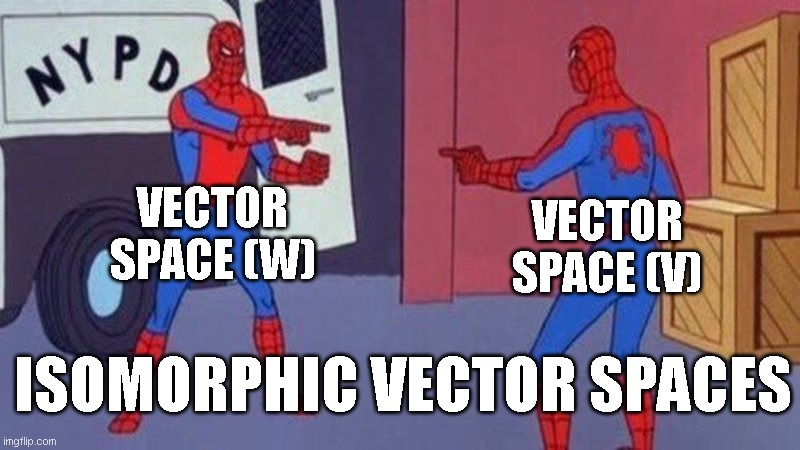
Linear Mappings
Consider
V,W∈R A mapping Φ:V→W preserves the vector space
If
Φ(x+y)=Φ(x)+Φ(y) Φ(λx)=λΦ(x) ∀x,y∈V and λ∈R
What a mapping? and why did you start with a formula?
Good question. It's because you might realize this from the property of distributivity but with a different symbol. And that's it!
It's preserving the vector while being able to scale it and don't forget with mathematical notations, Phi can be anything so long as it doesn't violate any rules stated, it can be a scalar, a vector, a matrix, even a set!... Actually it can't be a set, I'd get slapped by a mathematician for trying to map a vector with a set.
What use is mapping?
I don't know :D but much like in Panda's map (It's a python library) a mapping can be a an important tool and I see similarities from this type of mapping.
Also, the mapping itself isn't the main topic, it's:
Linear mapping
A mapping is called linear mapping if:
∀x,y∈V,∀λ and Ψ∈R: Φ(λx+Ψy)=λΦ(x)+ΨΦ(y)
That means that it's defined as linear mapping when a mapping is done to a vector and will result in a vector. Linear mapping can also be called linear transformation / vector space homomorphism
Consider a mapping
A mapping Φ:V→W Where V,W can be arbitrary sets
Phi will be called differently depending on the conditions
Injective
∀x,y∈V:Φ(x)=Φ(y)→x=y
Surjective
Φ(V)=W
This means that every element in W can be reached from V using Phi
Bijective
Ψ∘Φ(x)=x
Bijective will fulfill both injective and surjective. This can be undone by mapping the inverse of the previous mapping
Ψ:W→V textWhereΨ=Φ−1
Special cases of linear mapping
text1.Isomorphism:Φ:V→WLinear and Bijective text2.Endomorphism:Φ:V→VLinear text3.Automorphism:Ψ:V→VLinear and Bijective
Example
Φ:R→C,Φ(x)=x1+ix2
Φ([x1 x2]+[y1 y2])=x1+ix2+y1+iy2 =Φ([x1 x2])+Φ([y1 y2])
On the other hand :
Φ(λ[x1 x2])=λx1+iλx2 =λ(x1+ix2)=Φλ([x1 x2])
Finite-dimensional vector
(From theorem 3.59 in Axler, 2015)
V and W is isomorphic if and only if dim(V) = dim(W)
Intuition
This means that V and W are kind of the same thing, since they can be transformed to one another without incurring any loss.
Consider the vector V, W, X
For linear mappings:
Φ:V→W and Ψ:W→X
the mapping that is also linear will be
Φ∘ΦV→X
For isomorphism
If:
Φ:V→W is an isomorphism
Then:
Φ−1:W→V is an isomorphism too
For linear mapping (2)
If:
Φ:V→W,Ψ:V→W are linear
Then:
Φ+Ψ and λΦ,λ∈R are linear too
Acknowledgement
I can't overstate this: I'm truly grateful for this book being open-sourced for everyone. Many people will be able to learn and understand machine learning on a fundamental level. Whether changing careers, demystifying AI, or just learning in general, this book offers immense value even for fledgling composer such as myself. So, Marc Peter Deisenroth, A. Aldo Faisal, and Cheng Soon Ong, thank you for this book.
Source:
Axler, Sheldon. 2015. Linear Algebra Done Right. Springer
Deisenroth, M. P., Faisal, A. A., & Ong, C. S. (2020). Mathematics for Machine Learning. Cambridge: Cambridge University Press.
https://mml-book.com
